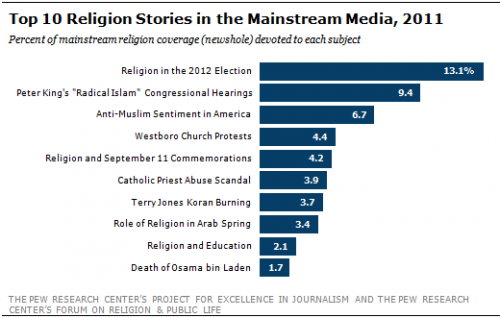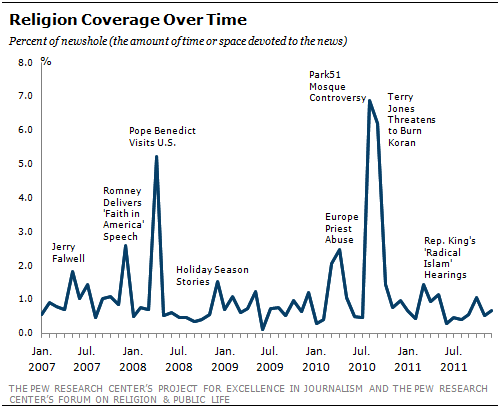Religion reporters: The 0.7 percent
 Last year, we were nearly giddy over a report that showed religion news had doubled ... to 2 percent of overall media coverage. Hey, we'll take it. In 2011, sadly, we did not see the same level of religion coverage in the press. A new analysis from Pew suggested that the coverage of religion went from 2 percent to .7 percent between 2010 and 2011. I enjoyed former religion beat reporter Eric Gorski's take: Religion reporters: You are the 0.7 percent.
Last year, we were nearly giddy over a report that showed religion news had doubled ... to 2 percent of overall media coverage. Hey, we'll take it. In 2011, sadly, we did not see the same level of religion coverage in the press. A new analysis from Pew suggested that the coverage of religion went from 2 percent to .7 percent between 2010 and 2011. I enjoyed former religion beat reporter Eric Gorski's take: Religion reporters: You are the 0.7 percent.
It's no surprise that politics, the economy and foreign policy tops the list, but unlike last year, religion was topped by celebrity/entertainment, the environment, crime and other news coverage.
Six of the top 10 religion stories in 2011 focused at least partly on Islam. Naturally, religion and the elections was the most covered religion story. What surprised me was that the second most covered religion story was Rep. Peter King's congressional hearing on radical Islam in the U.S., accounting for 9.4% of religion coverage. What was it about that story that reporters kept covering it?
The journalistic tendency is to cover conflict, so when religion did make news, it tended to be cover questions about extremism or intolerance. Overall, Islam was subject of 31.3 percent of the religion "newshole,” a higher amount compared to the percentage spent on Protestantism (20.1%), Catholicism (11.3%) and Mormonism (9.6%).
Religion and the 2012 election was 13.1 percent of all religion coverage, but it was down from four years earlier when campaign news made up 23.8 percent of 2007 religion coverage. In a reversal from last year, newspapers were somewhat more likely to cover religion, compared to cable TV, online outlets, radio and network news programs who were least likely to cover religion.
Specific stories trickled over from 2010 to 2011, such as Terry Jones, 9/11 commemorations, Westboro and the Catholic priest abuse scandal. Coverage of sexual abuse by Catholic priests received less coverage in 2011, receiving 3.9 percent of the religion coverage compared to 18.8 percent in 2010.
 Pew has studied religion in the media for five years now, concluding that religion generally receives little attention compared to the percentage of the country that practices religion.
Pew has studied religion in the media for five years now, concluding that religion generally receives little attention compared to the percentage of the country that practices religion.
In a country that is highly religious, the subject is not a major focus of the news. In the 60 months studied, the percentage of stories on religion in any given month rarely fluctuated above or below 1-2% of the space online, in print, on television and on the radio. Another conclusion is that religion tends to make news when it engenders controversy. Deeper questions of faith and its meaning are not, typically, news. Rather, much of the coverage is event-driven. The two biggest religion stories over the past five years were the intense controversy over plans to build an Islamic center, including a mosque, near the World Trade Center site, and Florida pastor Terry Jones’ announcement that his church would burn a Koran. The third-biggest story during that time was a visit by the pope to the U.S.
So are priorities at media outlets changing? Perhaps there are many topics that have a strong religion element in them that wouldn't fall in religion coverage per se. For instance, a story on Tim Tebow is not inherently religious, but several reporters covered a religion angle. Or perhaps we are seeing a real decline in religion-focused coverage. Just in the last month, the Chicago Tribune's religion blog, Beliefnet's Belief Beat and the Journal News's (New York) religion blog took a bow for reporters to move on to other duties. Perhaps reporter priorities are shifting away from blogs, but we hope that doesn't mean a shift away from the religion beat overall.
We will most likely continue to see religion and the campaign covered heavily this year, but it's worth considering whether the rest of religion coverage could suffer because of the attention given to politics.
Images Source: Pew Research Center’s Project for Excellence in Journalism and Pew Forum on Religion & Public Life, Copyright 2012, Pew Research Center. http://pewforum.org/.